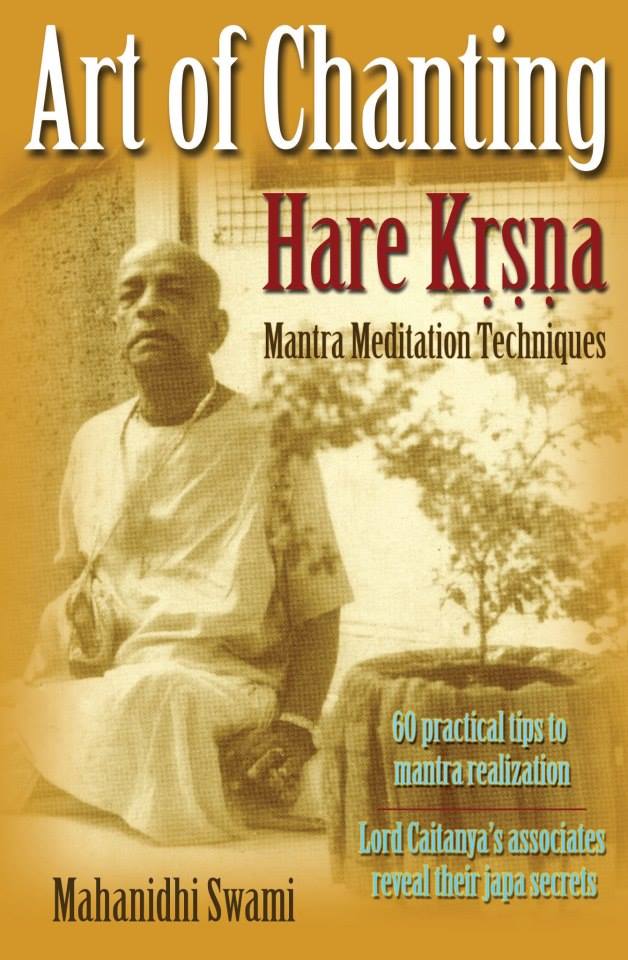Mahanidhi Madan Gopal Das
In Topmost Yoga System, Srila Prabhupada delivers a wonderful illumination on the holy name:
“The transcendental vibration established by the chanting of Hare Kṛṣṇa, Hare Kṛṣṇa, Kṛṣṇa Kṛṣṇa, Hare Hare/ Hare Rāma, Hare Rāma, Rāma Rāma, Hare Hare, is the sublime method for reviving our transcendental consciousness. As living spiritual souls, we are all originally Kṛṣṇa conscious entities, but due to our association with matter from time immemorial, our consciousness is now adulterated by the material atmosphere. The material atmosphere, in which we are now living, is called māyā, or illusion. Māyā means that which is not. And what is this illusion? The illusion is that we are all trying to be lords of material nature, while actually we are under the grip of her stringent laws.
“When a servant artificially tries to imitate the all-powerful master, it is called illusion. We are trying to exploit the resources of material nature, but actually we are becoming more and more
entangled in her complexities. Therefore, although we are engaged in a hard struggle to conquer nature, we are ever more dependent on her. This illusory struggle against material nature can be stopped at once by revival of our eternal Kṛṣṇa consciousness.
“Hare Kṛṣṇa, Hare Kṛṣṇa, Kṛṣṇa Kṛṣṇa, Hare Hare is the transcendental process for reviving this original pure consciousness. By chanting this transcendental vibration, we can cleanse away all misgivings within our hearts. The basic principle of all such misgivings is the false consciousness that I am the lord of all I survey.
“Kṛṣṇa consciousness is not an artificial imposition on the mind. This consciousness is the original natural energy of the living entity. When we hear the transcendental vibration, this consciousness is revived. This simplest method of meditation is recommended for this age.
“By practical experience also, one can perceive that by chanting this mahā-mantra, or the Great Chanting for Deliverance, one can at once feel a transcendental ecstasy coming through from the spiritual stratum. In the material concept of life we are busy in the matter of sense gratification as if we were in the lower animal stage. A little elevated from this status of sense gratification, one is engaged in mental speculation for the purpose of getting out of the material clutches. A little elevated from this speculative status, when one is intelligent enough, one tries to find out the supreme cause of all causes–within and without. And when one is factually on the plane of spiritual understanding, surpassing the stages of sense, mind and intelligence, he is then on the transcendental plane.
“This chanting of the Hare Kṛṣṇa mantra is enacted from the spiritual platform, and thus this sound vibration surpasses all lower strata of consciousness–namely sensual, mental and intellectual. There is no need, therefore, to understand the language of the mantra, nor is there any need for mental speculation nor any intellectual adjustment for chanting this mahā-mantra. It is automatic, from the spiritual platform, and as such, anyone can take part in vibrating this transcendental sound without any previous qualification. In a more advanced stage, of course, one is not expected to commit offenses on grounds of spiritual understanding.
“In the beginning, there may not be the presence of all transcendental ecstasies, which are eight in number. These are: (1) Being stopped as though dumb, (2) perspiration, (3) standing up of hairs on the body, (4) dislocation of voice, (5) trembling, (6) fading of the body, (7) crying in ecstasy, and (
trance. But there is no doubt that chanting for a while takes one immediately to the spiritual platform, and one shows the first symptom of this in the urge to dance along with the chanting of the mantra. We have seen this practically. Even a child can take part in the chanting and dancing.
“Of course, for one who is too entangled in material life, it takes a little more time to come to the standard point, but even such a materially engrossed man is raised to the spiritual platform very quickly. When it is chanted by a pure devotee of the Lord in love, it has the greatest efficacy on hearers, and as such this chanting should be heard from the lips of a pure devotee of the Lord, so that immediate effects can be achieved. As far as possible, chanting from the lips of nondevotees should be avoided. Milk touched by the lips of a serpent has poisonous effects.
“The word Harā is the form of addressing the energy of the Lord, and the words Kṛṣṇa and Rāma are forms of addressing the Lord Himself. Both Kṛṣṇa and Rāma mean the supreme pleasure, and Harā is the supreme pleasure energy of the Lord, changed to Hare (Hah-ray) in the vocative. The supreme pleasure energy of the Lord helps us to reach the Lord.
“The material energy, called māyā, is also one of the multi-energies of the Lord. And we, the living entities, are also the energy, marginal energy, of the Lord. The living entities are described as superior to material energy. When the superior energy is in contact with the inferior energy, an incompatible situation arises; but when the superior marginal energy is in contact with the superior energy, called Harā, it is established in its happy, normal condition.
“These three words, namely Harā, Kṛṣṇa and Rāma, are the transcendental seeds of the mahā-mantra. The chanting is a spiritual call for the Lord and His energy, to give protection to the conditioned soul. This chanting is exactly like the genuine cry of a child for its mother’s presence. Mother Harā helps the devotee achieve the Father’s grace, and then Lord Kṛṣṇa reveals Himself to the devotee who chants this mantra sincerely. No other means of spiritual realization is as effective in this age of quarrel and hypocrisy as the mahā-mantra.”
Hare Kṛṣṇa Hare Kṛṣṇa Kṛṣṇa Kṛṣṇa Hare Hare
Hare Rama Hare Rama Rama Rama Hare Hare
An excerpt from the book Art of Chanting

